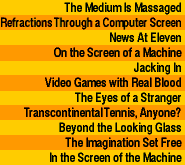


Refractions Through a Computer Screen
Producing realistic but fake video today takes lots of money. However, the technology is advancing briskly, the price is dropping rapidly, and the potential rewards are increasing enormously. By decade's end, fake video will be indistinguishable from the real thing. It's only a question of money.The film industry, for example, driven by the demand for ever more spectacular special effects, is moving rapidly toward all-electronic movie production. In the 1990s, technology gave us special effects films like Terminator 2: Judgment Day, Jurassic Park, Forrest Gump,and Toy Story, all of which stunned audiences worldwide. But they are only the beginning of what will soon be possible for much less money. Within a few decades we may have the first computer-generated live-action movie. It will look as if it were shot with real cameras and real actors at real locations. Yet it will all be make-believe. Such a film may look even more real in some ways than today's camera-created movies, because the computer could simulate such things as the tiny starbursts of eyelash diffraction we see when looking into a bright light on a dark night, the rainbow-tinted view through rain-wet eyelashes on a bright day, or the subtle blurring of tears.
Of course, the film industry probably won't go in for such subtleties at first. We're more likely to first see bright, vivid colors, speedlines in car chases, and extra bright muzzle flashes for the gunfight in the last scene. But tomorrow's Fellinis, Truffauts, Kubricks, and Kurosawas are probably playing video games today. When they grow up their genius will give us art that uses the computer with the same nuance and sensitivity that today's best directors bring to film.
Such computer technology might give directors yet more power over actors. Today, Humphrey Bogart, though long-dead, is again starring in new films as computers let us extract and piece together his images from old films. But that's only a crude step along the way. With enough money and time we'll be able to create "body-maps" of dead actors that detail their speech, walk, gestures, and so on, letting us make them do scenes they never acted in.
Eventually, living actors may license their body-maps so that their voices, expressions, gestures, and body movements can be recreated in any sequence. Perhaps in the future, we might ourselves use the body-maps of famous actors just as we now drive someone else's car. A few years later, filmmakers may not even need to model their creations after real actors; by then computers might be able to make human figures with their own special characteristics out of whole cloth. Directors would then need only a few famous actors, recreating the rest of the cast from body-maps and, therefore, totally controlling them. If today's actors think the job market is tough, they have no idea what the competition might become twenty years from now.
On the other hand, as the price of the technology continues to plummet, directors will inevitably find themselves competing with actors, who could by then afford what would today be a multimillion-dollar movie studio.
What works for actors could also work for other performance artists. Instead of going to a studio to learn ballet, students may one day buy an adaptive body-mapped recording of a master going through the routine, with all movements recorded exactly. Students "driving" such a recording might then practice by putting their hands, feet, and bodies in the precise attitudes struck by the recorded master. They won't be watching a recording; they'll be inside it.
Suppose that someone copies and sells that recording. Would that be invasion of privacy? Copyright infringement? Piracy? When body images and movements become copyable information, what becomes of personhood?